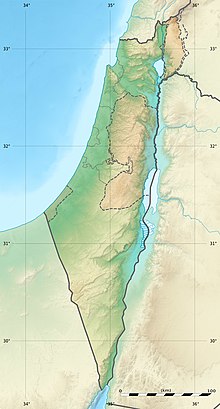| Battle of Megiddo | |||||||
|---|---|---|---|---|---|---|---|
| Part of Thutmose III's first campaign in the Levant | |||||||
 Aerial view of Tel Megiddo | |||||||
| |||||||
| Belligerents | |||||||
| Egyptian Empire | |||||||
| Commanders and leaders | |||||||
| Thutmose III |
| ||||||
| Strength | |||||||
| Unknown; modern estimates: ca. 10,800[1] | Unknown; modern estimates: ca. 10,700[1] | ||||||
| Casualties and losses | |||||||
| |||||||
Location within Israel | |||||||
This article needs additional citations for verification. (May 2024) |
The Battle of Megiddo (fought 15th century BC) was fought between Egyptian forces under the command of Pharaoh Thutmose III and a large rebellious coalition of Canaanite vassal states led by the king of Kadesh.[4] It is the first battle to have been recorded in what is accepted as relatively reliable detail.[5] Megiddo is also the first recorded use of the composite bow and the first body count.[6] All details of the battle come from Egyptian sources—primarily the hieroglyphic writings on the Hall of Annals in the Temple of Amun-Re at Karnak, Thebes (now Luxor), by the military scribe Tjaneni.
The ancient Egyptian account gives the date of the battle as the 21st day of the first month of the third season, of Year 23 of the reign of Thutmose III. It has been claimed that this was April 16, 1457 BC, according to the Middle Chronology,[citation needed] although other publications place the battle in 1482 BC or 1479 BC. The Egyptians routed the Canaanite forces, which fled to safety in the city of Megiddo. Their action resulted in the lengthy siege of Megiddo.
By reestablishing Egyptian dominance in the Levant, Thutmose III began a reign in which the Egyptian Empire reached its greatest expanse.
- ^ a b Redford, Donald (2003). The Wars in Syria and Palestine of Thutmose III. Culture and History of the Ancient Near East. Brill. pp. 197–198.
- ^ Nelson, Harold Hayden (1913). The Battle of Megiddo. University of Chicago Press. p. 53.
- ^ Keegan, John (1993). The History of Warfare. Key Porter Books. ISBN 1-55013-289-X.
- ^ Cline 2000 pp. 16–17
- ^ Watkins, Jack (2019). The Greatest Battles in History (2017 ed.). London, UK: Amber Books Ltd. p. 10. ISBN 978-1-78274-641-6.
- ^ Trevor N. Dupuy, Evolution of Weapons and Warfare.
